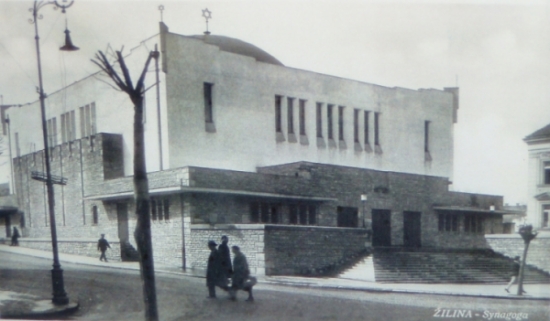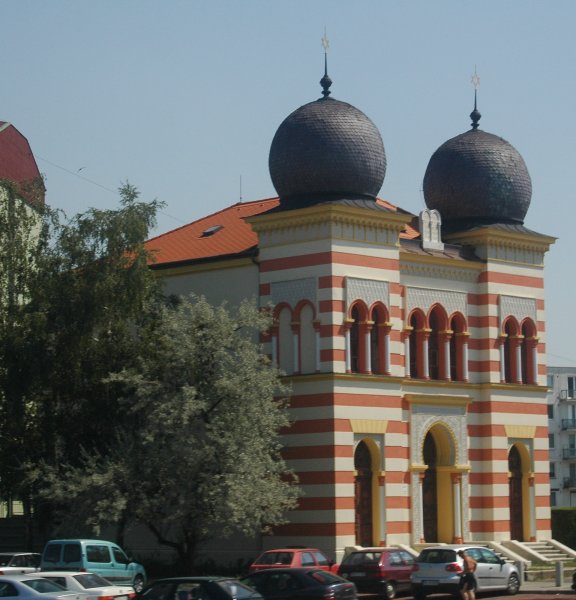|
Arnold Peter Weisz-Kubínčan
Arnold Peter Weisz-Kubínčan (3 March 1898 – 1945) was a Jewish Slovak painter. His works, many destroyed during the Holocaust, are considered to be among the most original artistic expressions of the Slovak interwar period. Biography He was born Arnold Weisz, to a Jewish family in Ujście, German Empire. When he was a child, his family moved to Dolný Kubín, in what is now Slovakia. From 1913 to 1917, he studied sculpture at the School of Applied Arts in Budapest. In 1917, he interrupted his studies to enlist in the army where he served on the Balkan Front in World War I. The next year, he resumed his studies in Berlin, where he became a part of the Expressionist art movement. In 1923, he returned to Dolný Kubín, later relocating to Martin in 1934. He began using the name Kubínčan in 1937, and adopted the name Peter after being baptized in 1940. In 1942, many Jews in Martin were taken and deported to concentration camps during the Holocaust in Slovakia. However, Weisz ... [...More Info...] [...Related Items...] OR: [Wikipedia] [Google] [Baidu] |
Ujście
Ujście () is a town in Piła County, Greater Poland Voivodeship, northwestern Poland, with 8,134 inhabitants (2011). It is situated at the confluence of the Gwda and Noteć rivers in the ethnocultural region of Krajna. History Although there was already a stronghold there in the 7th century, the earliest known mention of Ujście comes from the early 12th-century '' Gesta principum Polonorum'' chronicle. Its name means "mouth" in Polish, and refers to Ujście being the location of the river mouth of the Gwda. Ujście was a royal town, administratively located in the Poznań County in the Poznań Voivodeship in the Greater Poland Province. In 1655, it was the site of the Battle of Ujście during the Swedish invasion of Poland. In the Second Partition of Poland in 1793, when it was annexed by Prussia, and from 1871 it was part of Germany. Following the restoration of independent Poland after World War I, in 1920, the town was divided into two parts. The greater part was res ... [...More Info...] [...Related Items...] OR: [Wikipedia] [Google] [Baidu] |
The Holocaust In Slovakia
The Holocaust in Slovakia was the systematic dispossession, deportation, and murder of Jews in the Slovak Republic, a client state of Nazi Germany, during World War II. Out of 89,000 Jews in the country in 1940, an estimated 69,000 were murdered in the Holocaust. After the September 1938 Munich Agreement, Slovakia unilaterally declared its autonomy within Czechoslovakia, but lost significant territory to Hungary in the First Vienna Award, signed in November. The following year, with German encouragement, the ruling ethnonationalist Slovak People's Party declared independence from Czechoslovakia. The Slovak government blamed the Jews for the territorial losses. Jews were targeted for discrimination and harassment, including the confiscation of their property and businesses. The exclusion of Jews from the economy impoverished the community, which encouraged the government to conscript them for forced labor. On 9 September 1941, the government passed the Jewish Code, which it c ... [...More Info...] [...Related Items...] OR: [Wikipedia] [Google] [Baidu] |
1945 Deaths
1945 marked the end of World War II, the fall of Nazi Germany, and the Empire of Japan. It is also the year Nazi concentration camps, concentration camps were liberated and the only year in which atomic weapons Atomic bombings of Hiroshima and Nagasaki, have been used in combat. Events World War II will be abbreviated as “WWII” January * January 1 – WWII: ** Nazi Germany, Germany begins Operation Bodenplatte, an attempt by the ''Luftwaffe'' to cripple Allies of World War II, Allied air forces in the Low Countries. ** Chenogne massacre: German prisoners are allegedly killed by American forces near the village of Chenogne, Belgium. * January 6 – WWII: A German offensive recaptures Esztergom, Kingdom of Hungary (1920–1946), Hungary from the Soviets. * January 9 – WWII: American and Australian troops land at Lingayen Gulf on western coast of the largest Philippine island of Luzon, occupied by Japan since 1942. * January 12 – WWII: The Soviet Union begins the Vis ... [...More Info...] [...Related Items...] OR: [Wikipedia] [Google] [Baidu] |
1898 Births
Events January * January 1 – New York City annexes land from surrounding counties, creating the City of Greater New York as the world's second largest. The city is geographically divided into five boroughs: Manhattan, Brooklyn, Queens, The Bronx and Staten Island. * January 13 – Novelist Émile Zola's open letter to the President of the French Republic on the Dreyfus affair, , is published on the front page of the Paris daily newspaper , accusing the government of wrongfully imprisoning Alfred Dreyfus and of antisemitism. February * February 12 – The automobile belonging to Henry Lindfield of Brighton rolls out of control down a hill in Purley, London, England, and hits a tree; thus he becomes the world's first fatality from an automobile accident on a public highway. * February 15 – Spanish–American War: The explodes and sinks in Havana Harbor, Cuba, for reasons never fully established, killing 266 men. The event precipitates the United States' ... [...More Info...] [...Related Items...] OR: [Wikipedia] [Google] [Baidu] |
Slovak Expressionist Painters
Slovak may refer to: * Something from, related to, or belonging to Slovakia (''Slovenská republika'') * Slovaks, a Western Slavic ethnic group * Slovak language, an Indo-European language that belongs to the West Slavic languages * Slovak, Arkansas, United States See also * Slovák, a surname * Slovák, the official newspaper of the Slovak People's Party Andrej Hlinka, Hlinka's Slovak People's Party (), also known as the Slovak People's Party (, SĽS) or the Hlinka Party, was a far-right Clerical fascism, clerico-fascist political party with a strong Catholic fundamentalism, Catholic fundamental ... * {{disambiguation, geo Language and nationality disambiguation pages ... [...More Info...] [...Related Items...] OR: [Wikipedia] [Google] [Baidu] |
Czechoslovak Jews Who Died In The Holocaust
Czechoslovak may refer to: *A demonym or adjective pertaining to Czechoslovakia (1918–93) **First Czechoslovak Republic (1918–38) **Second Czechoslovak Republic (1938–39) **Third Czechoslovak Republic (1948–60) **Fourth Czechoslovak Republic (1960–89) **Fifth Czechoslovak Republic (1989–93) *''Czechoslovak'', also ''Czecho-Slovak'', any grouping of the Czech and Slovak ethnicities: **As a national identity, see Czechoslovakism **The title of Symphony no. 8 in G Major op. 88 by Antonín Dvořák in 1889/90 *The Czech–Slovak languages, a West Slavic dialect continuum **The Czechoslovak language, a theoretical standardized form defined as the state language of Czechoslovakia in its Constitution of 1920 **Comparison of Czech and Slovak See also * Slovak Republic (other) * Czech Republic (other) * Czechia (other) * Slovak (other) * Czech (other) Czech may refer to: * Anything from or related to the Czech Republic, a country ... [...More Info...] [...Related Items...] OR: [Wikipedia] [Google] [Baidu] |
Slovak Jews
The history of the Jews in Slovakia goes back to the 11th century, when the first Jews settled in the area. Early history In the 14th century, about 800 Jews lived in Bratislava, the majority of them engaged in commerce and money lending. In the early 15th century, a Jewish cemetery was established at Tisinec and was in use until 1892. In 1494, a blood libel caused sixteen Jews to be burned at the stake in Trnava, and in 1526, after the Battle of Mohács, Jews were expelled from all major towns. In 1529, thirty Jews were burned at the stake in Pezinok. In the late 17th century and early 18th century, Jews began to return to their original cities and establish organized communities, though they were barred from many trading industries and often in conflict with non-Jews. In 1683, hundreds of Jews from Moravia fled to the Hungarian Kingdom, seeking refuge from Kuruc riots and restrictions on their living imposed in Moravia. In 1700, a leading yeshiva was established in Bratisl ... [...More Info...] [...Related Items...] OR: [Wikipedia] [Google] [Baidu] |
Slovak National Gallery
The Slovak National Gallery (, abbreviated SNG) is a network of galleries in Slovakia. It has its headquarters in Bratislava. The gallery was established by law on 29 July 1949. In Bratislava, it has its displays situated in Esterházy Palace (''Esterházyho palác'') and the Water Barracks (''Vodné kasárne'') which are adjacent to each other. The Esterházy Palace was reconstructed for the purposes of the gallery in the 1950s and a modern extension was added in the 1970s. The SNG also manages other galleries outside Bratislava: at the Zvolen Castle in Zvolen, at the Strážky mansion in Spišská Belá, in Ružomberok and in Pezinok Pezinok (; in the local dialect ''Pezinek''; ; ; ) is a town in southwestern Slovakia. It is roughly northeast of Bratislava and, as of December 2023, had a population of 24,443. Pezinok lies near the Little Carpathians and thrives mainly on vi .... The '' Mourning portrait of K. Horvath-Stansith'' is considered one of the most significant ac ... [...More Info...] [...Related Items...] OR: [Wikipedia] [Google] [Baidu] |
United States
The United States of America (USA), also known as the United States (U.S.) or America, is a country primarily located in North America. It is a federal republic of 50 U.S. state, states and a federal capital district, Washington, D.C. The 48 contiguous states border Canada to the north and Mexico to the south, with the semi-exclave of Alaska in the northwest and the archipelago of Hawaii in the Pacific Ocean. The United States asserts sovereignty over five Territories of the United States, major island territories and United States Minor Outlying Islands, various uninhabited islands in Oceania and the Caribbean. It is a megadiverse country, with the world's List of countries and dependencies by area, third-largest land area and List of countries and dependencies by population, third-largest population, exceeding 340 million. Its three Metropolitan statistical areas by population, largest metropolitan areas are New York metropolitan area, New York, Greater Los Angeles, Los Angel ... [...More Info...] [...Related Items...] OR: [Wikipedia] [Google] [Baidu] |
Mauthausen Concentration Camp
Mauthausen was a German Nazi concentration camp on a hill above the market town of Mauthausen, Upper Austria, Mauthausen (roughly east of Linz), Upper Austria. It was the main camp of a group with List of subcamps of Mauthausen, nearly 100 further Subcamp (SS), subcamps located throughout Austria and southern Germany. The three Gusen concentration camps in and around the village of Sankt Georgen an der Gusen, St. Georgen/Gusen, just a few kilometres from Mauthausen, held a significant proportion of prisoners within the camp complex, at times exceeding the number of prisoners at the Mauthausen main camp. The Mauthausen main camp operated from 8 August 1938, several months after the Anschluss, German annexation of Austria, to 5 May 1945, when it was liberated by the United States Army. Starting with the camp at Mauthausen, the number of subcamps expanded over time. In January 1945, the camps contained roughly 85,000 inmates. As at other Nazi concentration camps, the inmates at ... [...More Info...] [...Related Items...] OR: [Wikipedia] [Google] [Baidu] |
Sachsenhausen Concentration Camp
Sachsenhausen () or Sachsenhausen-Oranienburg was a German Nazi concentration camp in Oranienburg, Germany, used from 1936 until April 1945, shortly before the defeat of Nazi Germany in May later that year. It mainly held political prisoners throughout World War II. Prominent prisoners included Joseph Stalin's oldest son, Yakov Dzhugashvili; assassin Herschel Grynszpan; Paul Reynaud, the penultimate prime minister of the French Third Republic; Francisco Largo Caballero, prime minister of the Second Spanish Republic during the Spanish Civil War; the wife and children of the Albrecht, Duke of Bavaria, crown prince of Bavaria; Ukrainian nationalist leader Stepan Bandera; and several enemy soldiers and political dissidents. Sachsenhausen was a labour camp, outfitted with several subcamps, a gas chamber, and a medical experimentation area. Prisoners were treated inhumanely, fed inadequately, and killed openly. After World War II, when Oranienburg was in the Soviet Occupation Zone, t ... [...More Info...] [...Related Items...] OR: [Wikipedia] [Google] [Baidu] |




